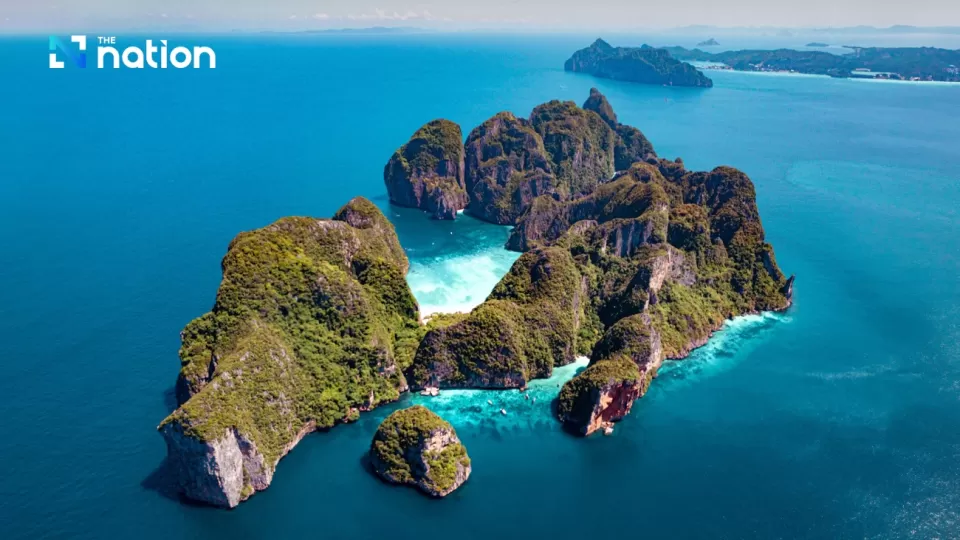March 1, 2024
BANGKOK – The closure aimed to allow the damaged coral reefs and marine life to recover. Then after COVID, the government reopened Maya Bay but with strict regulations in place to protect its natural resources. They continue to close the beach of Maya Bay every year for two months to assist with the environmental protection.
Dr Thon Thamrongnawasawat, a marine biologist at Kasetsart University, said “the target point for Maya bay was to set up a system that would help us, and would become a permanent system that would still allow tourists to enjoy Maya Bay. We used to get about 6,000-7,000 tourists visiting everyday.”
Before the closure, more than 100 long-tailed boats parked daily on the sandy white beaches. This completely destroyed the shallow coral reef in Maya bay, as well as disturbing sharks that used Maya bay as hunting ground and as a nursery to lay their eggs.
Back before the closure there were 0 sharks, Dr. Thon points out, but today there are about 60 sharks in the Maya bay area.
Now, only 300 visitors are allowed per hour in Maya bay. Piers were added on the back of the island, and wooden boardwalks were installed for people to walk across the sandy island to Maya bay, rather than walking directly on the island grounds. People are only allowed knee-deep in the water, and National Park rangers sit on the beach and blow a whistle warning to tourists who venture too deep.
As for the coral, prior to the shut-down only 8% were classified as “living,” but by 2023 that number had grown to 20-30%. Dr.Thon does not expect the live coral to reach to 50% anytime soon, because it will take 10-15 years for it to grow back to what it was 50 years ago.
The main goal of the Maya Bay restoration project was to let Mother nature restore herself. The marine biologist predicted that in 20 years Maya Bay would return to its glory of 50 years ago.
The success comes from the work of many interested people and groups. It is telling that no one is currently questioning the system, asking to bring in more tourists, asking to go through the bay with speed boats. The system is working well, has proved itself, and the result is public compliance.
The 2003 global animated film phenomenon “Finding Nemo” had consequences for clownfish populations, worsening their already declining numbers. The beloved film sparked a surge in demand for clownfish as pets and this trend coincided with ongoing challenges faced by clownfish populations in areas like Maya Bay, where environmental degradation and tourism pressures were already taking their toll.
In response to these threats, initiatives such as the clownfish and shark restoration project led by Saii Village were launched. These efforts have yielded promising results, with observable improvements in the populations of both species. However, despite these positive developments, a significant portion of clownfish available in markets are not sourced from the ocean, highlighting persistent challenges in conservation.
The decline of specific coral habitats crucial for clownfish survival threatens their long-term viability. As these habitats continue to diminish, clownfish populations face an uncertain future, underscoring the urgent need for sustained conservation efforts to protect both the species and their habitats.
Recognising the urgency of the situation, SAii Resorts, along with partners S Hotels & Resorts and Singha Estate worked with government officials and local NGOs to tackle the environmental crisis. At the heart of these efforts is the Marine Development Centre at Saii Village Phi Phi Island, where dedicated marine biologists are working to restore marine ecosystems.
The Marine Development Centre will hopefully play a role in increasing biodiversity by 30% by 2030. Progress is being made, with seagrass coverage in front of the hotel’s shore expanding by 158 square metres since 2022. Additionally, a collaborative agreement has been established with the local community in Koh Phi Phi to preserve biodiversity across 192,000 square metres of natural habitat.
The “Save Our Sharks” (SOS) programme was initiated by SAii Resorts and aims to bolster shark populations in the Andaman Sea. Through partnerships with the Phuket Marine Biological Centre, SAii Resorts has released bamboo sharks and established a nursery for shark eggs.
The programme has released 30 sharks and nurtured 29 shark eggs, offering hope for the recovery of shark populations in the region. A few years ago, there were no sharks in the Phi Phi Island area but today 60 sharks can be found — and this is due to a cluster of efforts, most particularly the shark nursery, and the initial closing and continued restrictions at Maya Bay.


